The Effect of FGM on West African Females in London, UK
VerifiedAdded on 2022/08/13
|35
|8058
|20
Report
AI Summary
This report investigates the effects of Female Genital Mutilation (FGM) on West African females aged 5 to 21 residing in London, UK. The study examines the physical, psychological, and social impacts of FGM, drawing on both primary and secondary research. Secondary data was collected from scholarly sources, including journals and systematic reviews. The research explores the negative effects on sexuality, physical and emotional health, and the influence of cultural and religious views. It also reviews UK policies aimed at eradicating FGM and identifies contributing factors. The findings reveal the detrimental health consequences, including physical complications, sexual dysfunctions, and emotional and psychological issues. The report concludes that FGM has no health benefits and makes recommendations for improving care and combating the practice.
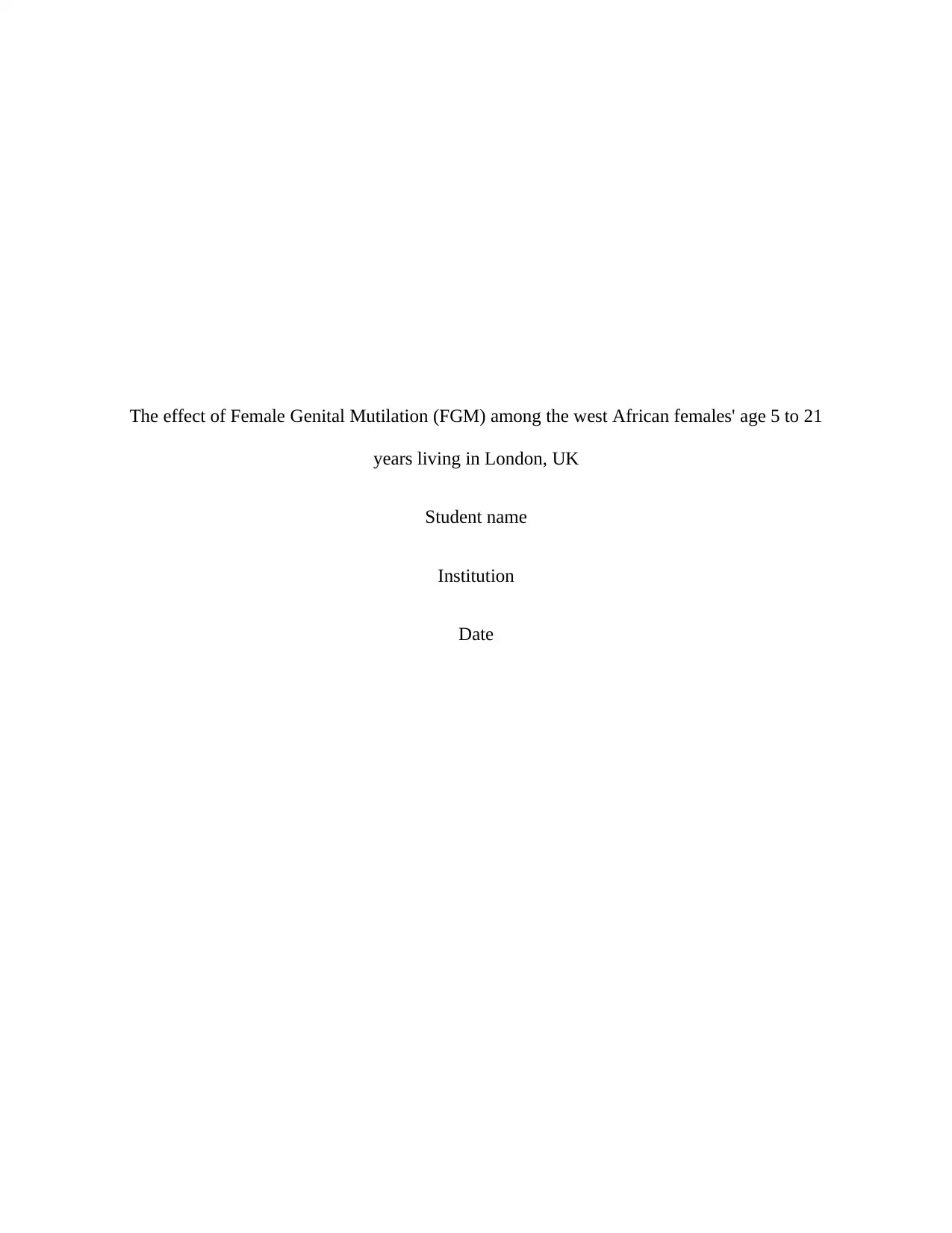
The effect of Female Genital Mutilation (FGM) among the west African females' age 5 to 21
years living in London, UK
Student name
Institution
Date
years living in London, UK
Student name
Institution
Date
Paraphrase This Document
Need a fresh take? Get an instant paraphrase of this document with our AI Paraphraser
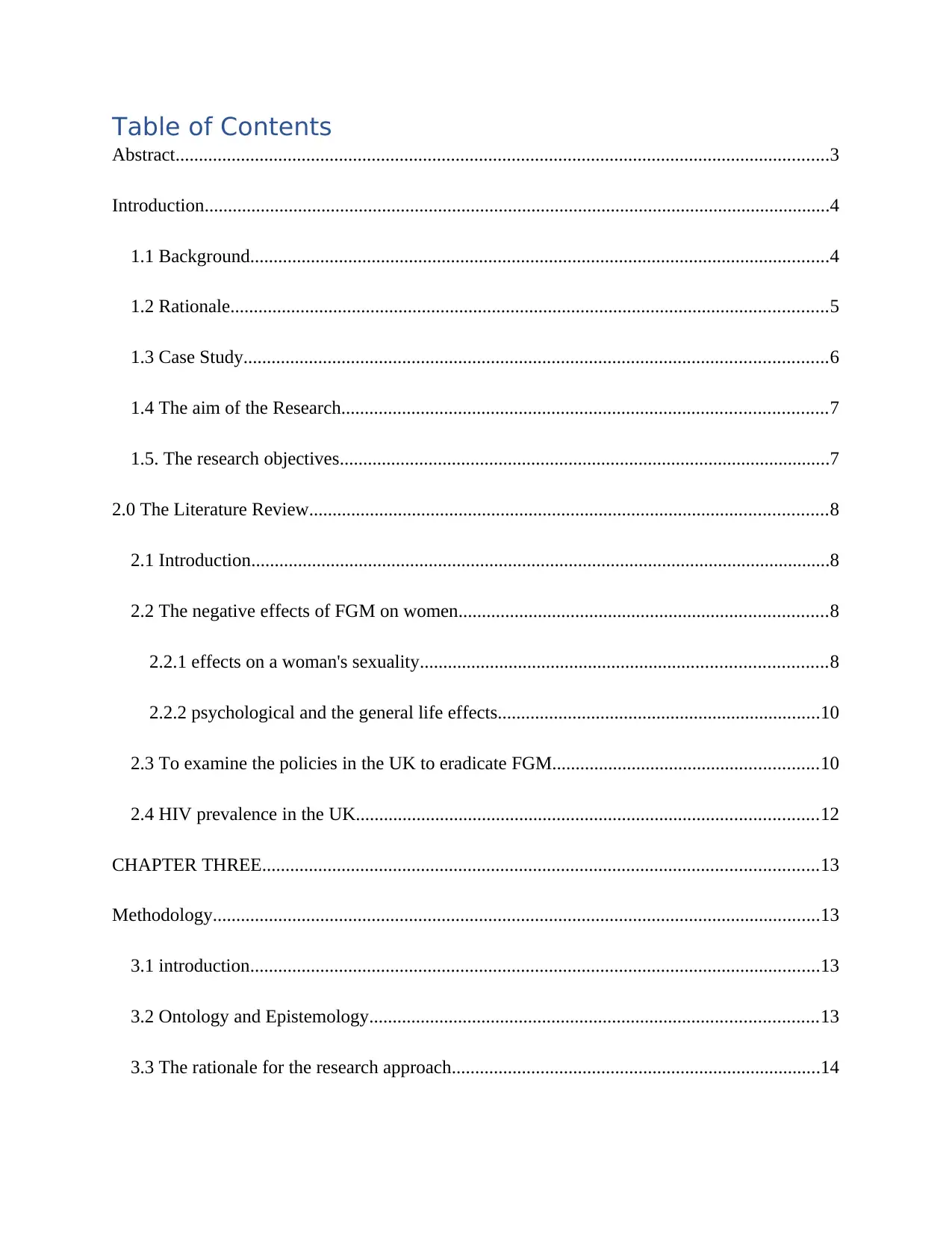
Table of Contents
Abstract............................................................................................................................................3
Introduction......................................................................................................................................4
1.1 Background............................................................................................................................4
1.2 Rationale................................................................................................................................5
1.3 Case Study.............................................................................................................................6
1.4 The aim of the Research........................................................................................................7
1.5. The research objectives.........................................................................................................7
2.0 The Literature Review...............................................................................................................8
2.1 Introduction............................................................................................................................8
2.2 The negative effects of FGM on women...............................................................................8
2.2.1 effects on a woman's sexuality.......................................................................................8
2.2.2 psychological and the general life effects.....................................................................10
2.3 To examine the policies in the UK to eradicate FGM.........................................................10
2.4 HIV prevalence in the UK...................................................................................................12
CHAPTER THREE.......................................................................................................................13
Methodology..................................................................................................................................13
3.1 introduction..........................................................................................................................13
3.2 Ontology and Epistemology................................................................................................13
3.3 The rationale for the research approach...............................................................................14
Abstract............................................................................................................................................3
Introduction......................................................................................................................................4
1.1 Background............................................................................................................................4
1.2 Rationale................................................................................................................................5
1.3 Case Study.............................................................................................................................6
1.4 The aim of the Research........................................................................................................7
1.5. The research objectives.........................................................................................................7
2.0 The Literature Review...............................................................................................................8
2.1 Introduction............................................................................................................................8
2.2 The negative effects of FGM on women...............................................................................8
2.2.1 effects on a woman's sexuality.......................................................................................8
2.2.2 psychological and the general life effects.....................................................................10
2.3 To examine the policies in the UK to eradicate FGM.........................................................10
2.4 HIV prevalence in the UK...................................................................................................12
CHAPTER THREE.......................................................................................................................13
Methodology..................................................................................................................................13
3.1 introduction..........................................................................................................................13
3.2 Ontology and Epistemology................................................................................................13
3.3 The rationale for the research approach...............................................................................14
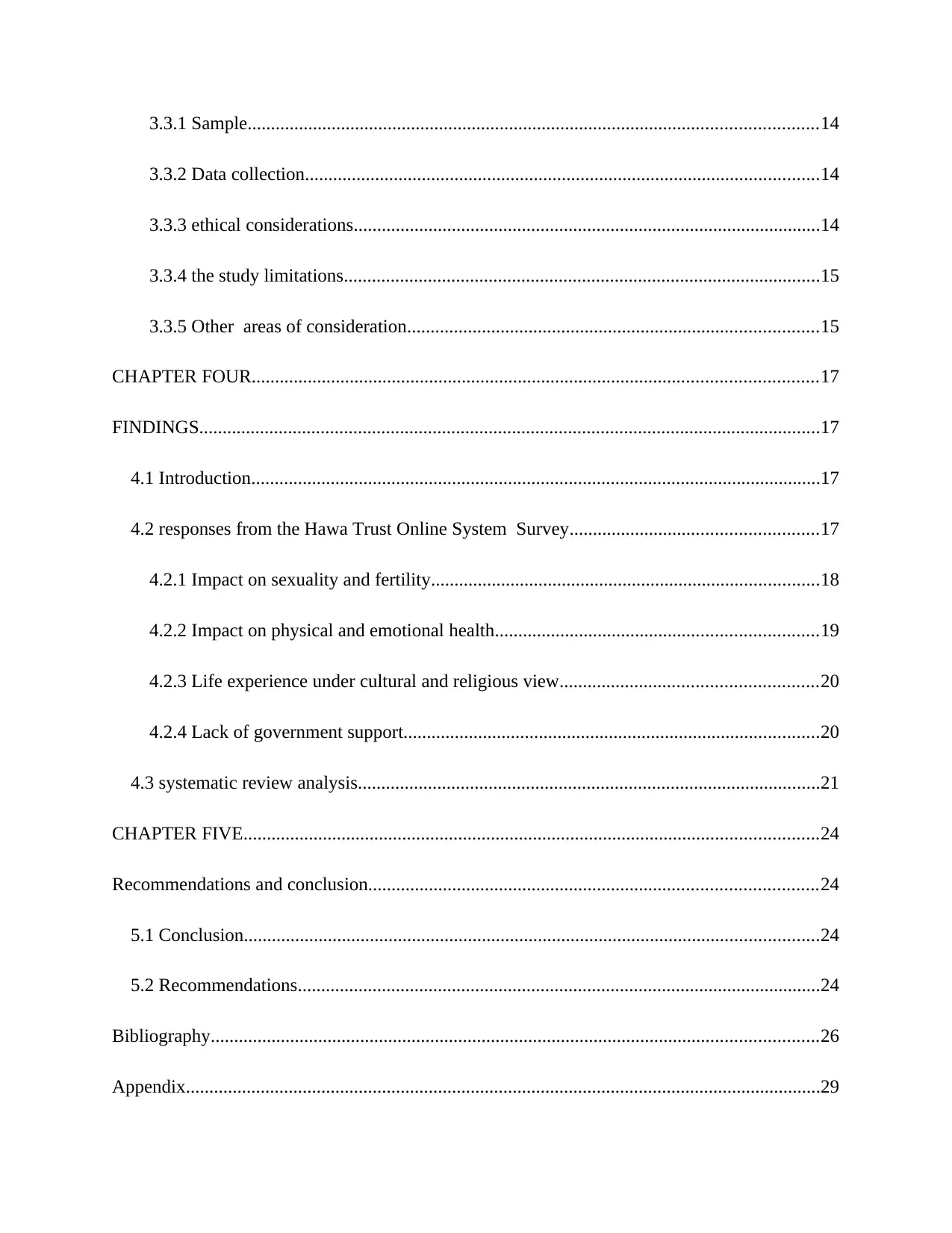
3.3.1 Sample..........................................................................................................................14
3.3.2 Data collection..............................................................................................................14
3.3.3 ethical considerations....................................................................................................14
3.3.4 the study limitations......................................................................................................15
3.3.5 Other areas of consideration........................................................................................15
CHAPTER FOUR.........................................................................................................................17
FINDINGS.....................................................................................................................................17
4.1 Introduction..........................................................................................................................17
4.2 responses from the Hawa Trust Online System Survey.....................................................17
4.2.1 Impact on sexuality and fertility...................................................................................18
4.2.2 Impact on physical and emotional health.....................................................................19
4.2.3 Life experience under cultural and religious view.......................................................20
4.2.4 Lack of government support.........................................................................................20
4.3 systematic review analysis...................................................................................................21
CHAPTER FIVE...........................................................................................................................24
Recommendations and conclusion................................................................................................24
5.1 Conclusion...........................................................................................................................24
5.2 Recommendations................................................................................................................24
Bibliography..................................................................................................................................26
Appendix........................................................................................................................................29
3.3.2 Data collection..............................................................................................................14
3.3.3 ethical considerations....................................................................................................14
3.3.4 the study limitations......................................................................................................15
3.3.5 Other areas of consideration........................................................................................15
CHAPTER FOUR.........................................................................................................................17
FINDINGS.....................................................................................................................................17
4.1 Introduction..........................................................................................................................17
4.2 responses from the Hawa Trust Online System Survey.....................................................17
4.2.1 Impact on sexuality and fertility...................................................................................18
4.2.2 Impact on physical and emotional health.....................................................................19
4.2.3 Life experience under cultural and religious view.......................................................20
4.2.4 Lack of government support.........................................................................................20
4.3 systematic review analysis...................................................................................................21
CHAPTER FIVE...........................................................................................................................24
Recommendations and conclusion................................................................................................24
5.1 Conclusion...........................................................................................................................24
5.2 Recommendations................................................................................................................24
Bibliography..................................................................................................................................26
Appendix........................................................................................................................................29
⊘ This is a preview!⊘
Do you want full access?
Subscribe today to unlock all pages.

Trusted by 1+ million students worldwide

Appendix 1: Annotated Bibliography........................................................................................29
Paraphrase This Document
Need a fresh take? Get an instant paraphrase of this document with our AI Paraphraser
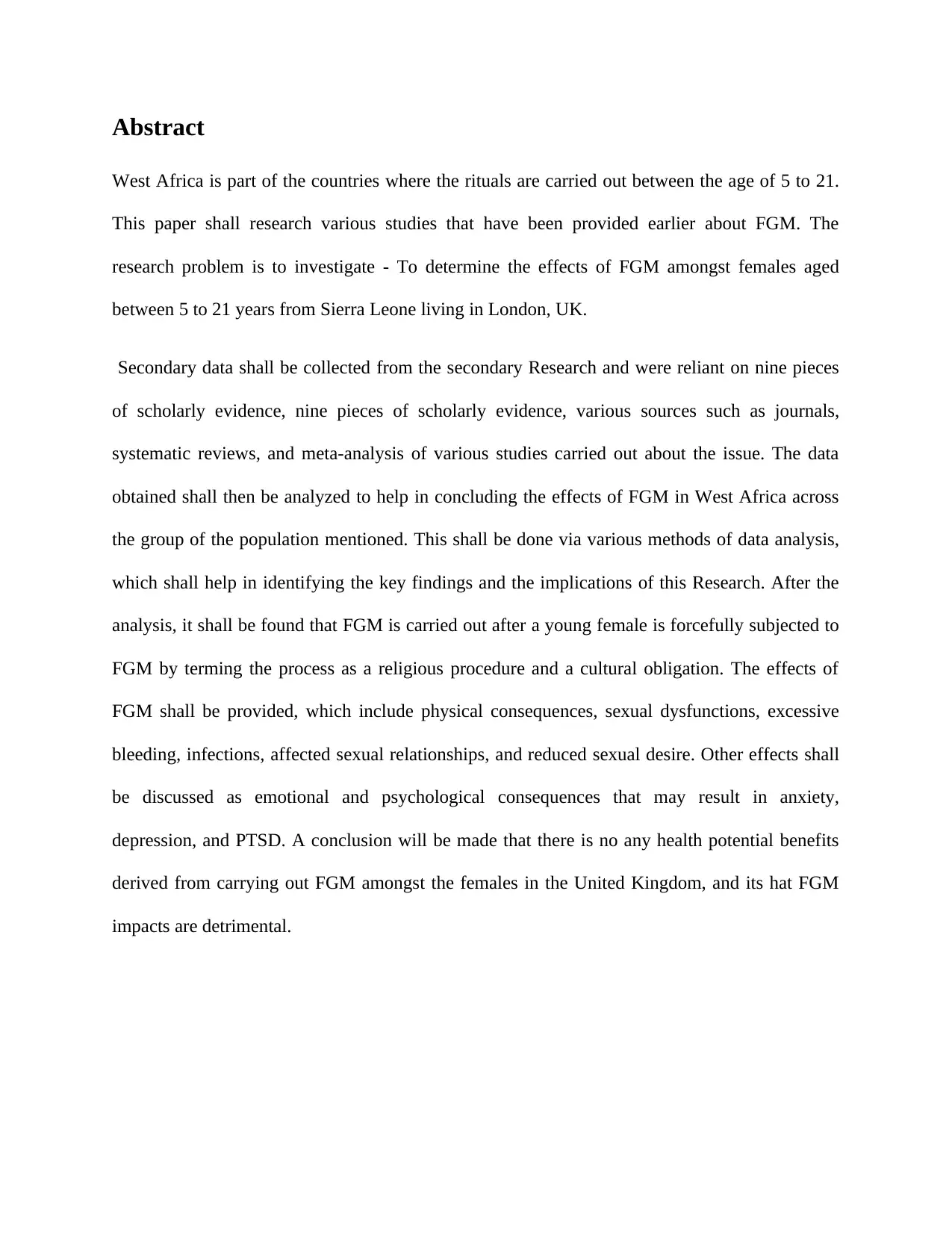
Abstract
West Africa is part of the countries where the rituals are carried out between the age of 5 to 21.
This paper shall research various studies that have been provided earlier about FGM. The
research problem is to investigate - To determine the effects of FGM amongst females aged
between 5 to 21 years from Sierra Leone living in London, UK.
Secondary data shall be collected from the secondary Research and were reliant on nine pieces
of scholarly evidence, nine pieces of scholarly evidence, various sources such as journals,
systematic reviews, and meta-analysis of various studies carried out about the issue. The data
obtained shall then be analyzed to help in concluding the effects of FGM in West Africa across
the group of the population mentioned. This shall be done via various methods of data analysis,
which shall help in identifying the key findings and the implications of this Research. After the
analysis, it shall be found that FGM is carried out after a young female is forcefully subjected to
FGM by terming the process as a religious procedure and a cultural obligation. The effects of
FGM shall be provided, which include physical consequences, sexual dysfunctions, excessive
bleeding, infections, affected sexual relationships, and reduced sexual desire. Other effects shall
be discussed as emotional and psychological consequences that may result in anxiety,
depression, and PTSD. A conclusion will be made that there is no any health potential benefits
derived from carrying out FGM amongst the females in the United Kingdom, and its hat FGM
impacts are detrimental.
West Africa is part of the countries where the rituals are carried out between the age of 5 to 21.
This paper shall research various studies that have been provided earlier about FGM. The
research problem is to investigate - To determine the effects of FGM amongst females aged
between 5 to 21 years from Sierra Leone living in London, UK.
Secondary data shall be collected from the secondary Research and were reliant on nine pieces
of scholarly evidence, nine pieces of scholarly evidence, various sources such as journals,
systematic reviews, and meta-analysis of various studies carried out about the issue. The data
obtained shall then be analyzed to help in concluding the effects of FGM in West Africa across
the group of the population mentioned. This shall be done via various methods of data analysis,
which shall help in identifying the key findings and the implications of this Research. After the
analysis, it shall be found that FGM is carried out after a young female is forcefully subjected to
FGM by terming the process as a religious procedure and a cultural obligation. The effects of
FGM shall be provided, which include physical consequences, sexual dysfunctions, excessive
bleeding, infections, affected sexual relationships, and reduced sexual desire. Other effects shall
be discussed as emotional and psychological consequences that may result in anxiety,
depression, and PTSD. A conclusion will be made that there is no any health potential benefits
derived from carrying out FGM amongst the females in the United Kingdom, and its hat FGM
impacts are detrimental.
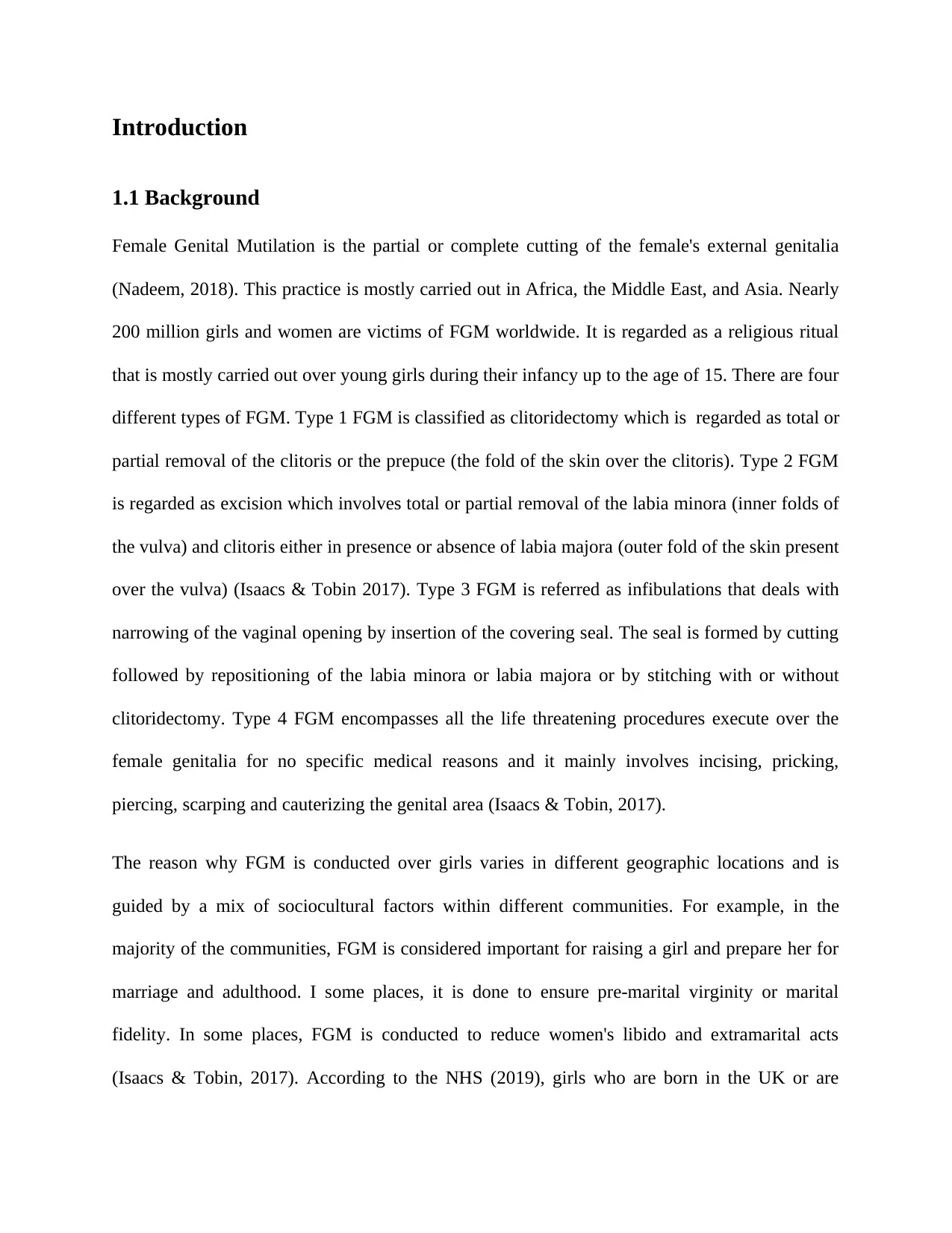
Introduction
1.1 Background
Female Genital Mutilation is the partial or complete cutting of the female's external genitalia
(Nadeem, 2018). This practice is mostly carried out in Africa, the Middle East, and Asia. Nearly
200 million girls and women are victims of FGM worldwide. It is regarded as a religious ritual
that is mostly carried out over young girls during their infancy up to the age of 15. There are four
different types of FGM. Type 1 FGM is classified as clitoridectomy which is regarded as total or
partial removal of the clitoris or the prepuce (the fold of the skin over the clitoris). Type 2 FGM
is regarded as excision which involves total or partial removal of the labia minora (inner folds of
the vulva) and clitoris either in presence or absence of labia majora (outer fold of the skin present
over the vulva) (Isaacs & Tobin 2017). Type 3 FGM is referred as infibulations that deals with
narrowing of the vaginal opening by insertion of the covering seal. The seal is formed by cutting
followed by repositioning of the labia minora or labia majora or by stitching with or without
clitoridectomy. Type 4 FGM encompasses all the life threatening procedures execute over the
female genitalia for no specific medical reasons and it mainly involves incising, pricking,
piercing, scarping and cauterizing the genital area (Isaacs & Tobin, 2017).
The reason why FGM is conducted over girls varies in different geographic locations and is
guided by a mix of sociocultural factors within different communities. For example, in the
majority of the communities, FGM is considered important for raising a girl and prepare her for
marriage and adulthood. I some places, it is done to ensure pre-marital virginity or marital
fidelity. In some places, FGM is conducted to reduce women's libido and extramarital acts
(Isaacs & Tobin, 2017). According to the NHS (2019), girls who are born in the UK or are
1.1 Background
Female Genital Mutilation is the partial or complete cutting of the female's external genitalia
(Nadeem, 2018). This practice is mostly carried out in Africa, the Middle East, and Asia. Nearly
200 million girls and women are victims of FGM worldwide. It is regarded as a religious ritual
that is mostly carried out over young girls during their infancy up to the age of 15. There are four
different types of FGM. Type 1 FGM is classified as clitoridectomy which is regarded as total or
partial removal of the clitoris or the prepuce (the fold of the skin over the clitoris). Type 2 FGM
is regarded as excision which involves total or partial removal of the labia minora (inner folds of
the vulva) and clitoris either in presence or absence of labia majora (outer fold of the skin present
over the vulva) (Isaacs & Tobin 2017). Type 3 FGM is referred as infibulations that deals with
narrowing of the vaginal opening by insertion of the covering seal. The seal is formed by cutting
followed by repositioning of the labia minora or labia majora or by stitching with or without
clitoridectomy. Type 4 FGM encompasses all the life threatening procedures execute over the
female genitalia for no specific medical reasons and it mainly involves incising, pricking,
piercing, scarping and cauterizing the genital area (Isaacs & Tobin, 2017).
The reason why FGM is conducted over girls varies in different geographic locations and is
guided by a mix of sociocultural factors within different communities. For example, in the
majority of the communities, FGM is considered important for raising a girl and prepare her for
marriage and adulthood. I some places, it is done to ensure pre-marital virginity or marital
fidelity. In some places, FGM is conducted to reduce women's libido and extramarital acts
(Isaacs & Tobin, 2017). According to the NHS (2019), girls who are born in the UK or are
⊘ This is a preview!⊘
Do you want full access?
Subscribe today to unlock all pages.

Trusted by 1+ million students worldwide
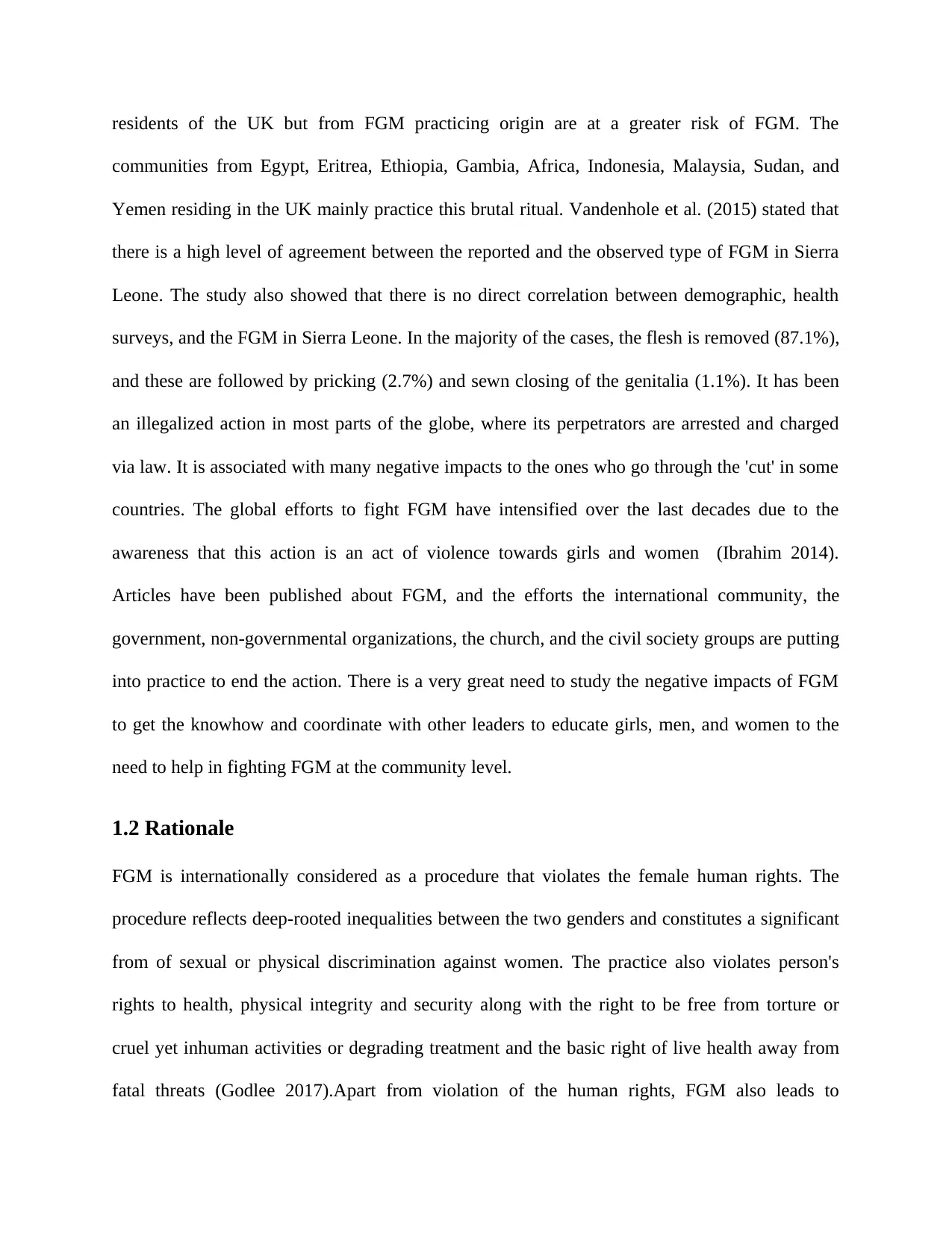
residents of the UK but from FGM practicing origin are at a greater risk of FGM. The
communities from Egypt, Eritrea, Ethiopia, Gambia, Africa, Indonesia, Malaysia, Sudan, and
Yemen residing in the UK mainly practice this brutal ritual. Vandenhole et al. (2015) stated that
there is a high level of agreement between the reported and the observed type of FGM in Sierra
Leone. The study also showed that there is no direct correlation between demographic, health
surveys, and the FGM in Sierra Leone. In the majority of the cases, the flesh is removed (87.1%),
and these are followed by pricking (2.7%) and sewn closing of the genitalia (1.1%). It has been
an illegalized action in most parts of the globe, where its perpetrators are arrested and charged
via law. It is associated with many negative impacts to the ones who go through the 'cut' in some
countries. The global efforts to fight FGM have intensified over the last decades due to the
awareness that this action is an act of violence towards girls and women (Ibrahim 2014).
Articles have been published about FGM, and the efforts the international community, the
government, non-governmental organizations, the church, and the civil society groups are putting
into practice to end the action. There is a very great need to study the negative impacts of FGM
to get the knowhow and coordinate with other leaders to educate girls, men, and women to the
need to help in fighting FGM at the community level.
1.2 Rationale
FGM is internationally considered as a procedure that violates the female human rights. The
procedure reflects deep-rooted inequalities between the two genders and constitutes a significant
from of sexual or physical discrimination against women. The practice also violates person's
rights to health, physical integrity and security along with the right to be free from torture or
cruel yet inhuman activities or degrading treatment and the basic right of live health away from
fatal threats (Godlee 2017).Apart from violation of the human rights, FGM also leads to
communities from Egypt, Eritrea, Ethiopia, Gambia, Africa, Indonesia, Malaysia, Sudan, and
Yemen residing in the UK mainly practice this brutal ritual. Vandenhole et al. (2015) stated that
there is a high level of agreement between the reported and the observed type of FGM in Sierra
Leone. The study also showed that there is no direct correlation between demographic, health
surveys, and the FGM in Sierra Leone. In the majority of the cases, the flesh is removed (87.1%),
and these are followed by pricking (2.7%) and sewn closing of the genitalia (1.1%). It has been
an illegalized action in most parts of the globe, where its perpetrators are arrested and charged
via law. It is associated with many negative impacts to the ones who go through the 'cut' in some
countries. The global efforts to fight FGM have intensified over the last decades due to the
awareness that this action is an act of violence towards girls and women (Ibrahim 2014).
Articles have been published about FGM, and the efforts the international community, the
government, non-governmental organizations, the church, and the civil society groups are putting
into practice to end the action. There is a very great need to study the negative impacts of FGM
to get the knowhow and coordinate with other leaders to educate girls, men, and women to the
need to help in fighting FGM at the community level.
1.2 Rationale
FGM is internationally considered as a procedure that violates the female human rights. The
procedure reflects deep-rooted inequalities between the two genders and constitutes a significant
from of sexual or physical discrimination against women. The practice also violates person's
rights to health, physical integrity and security along with the right to be free from torture or
cruel yet inhuman activities or degrading treatment and the basic right of live health away from
fatal threats (Godlee 2017).Apart from violation of the human rights, FGM also leads to
Paraphrase This Document
Need a fresh take? Get an instant paraphrase of this document with our AI Paraphraser
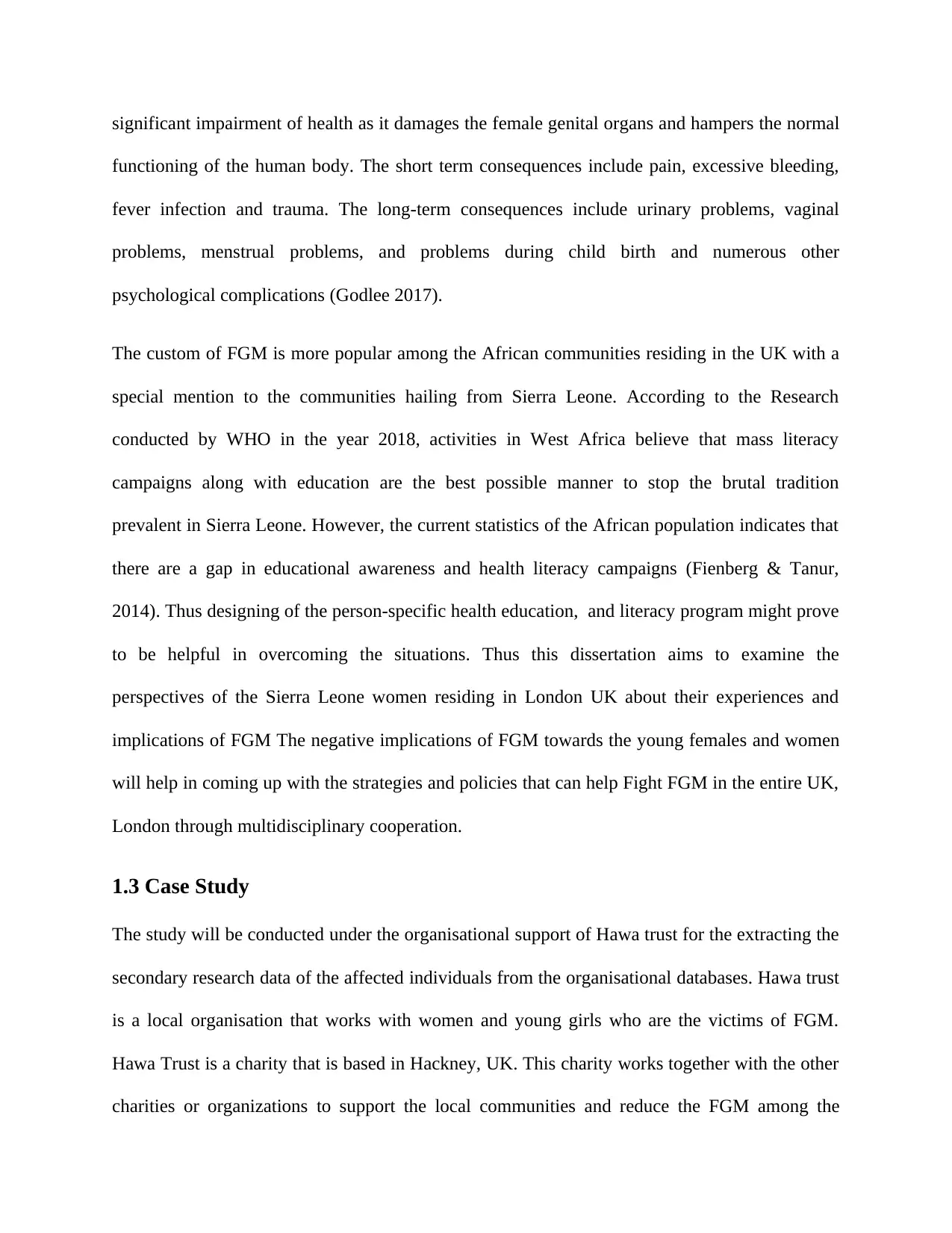
significant impairment of health as it damages the female genital organs and hampers the normal
functioning of the human body. The short term consequences include pain, excessive bleeding,
fever infection and trauma. The long-term consequences include urinary problems, vaginal
problems, menstrual problems, and problems during child birth and numerous other
psychological complications (Godlee 2017).
The custom of FGM is more popular among the African communities residing in the UK with a
special mention to the communities hailing from Sierra Leone. According to the Research
conducted by WHO in the year 2018, activities in West Africa believe that mass literacy
campaigns along with education are the best possible manner to stop the brutal tradition
prevalent in Sierra Leone. However, the current statistics of the African population indicates that
there are a gap in educational awareness and health literacy campaigns (Fienberg & Tanur,
2014). Thus designing of the person-specific health education, and literacy program might prove
to be helpful in overcoming the situations. Thus this dissertation aims to examine the
perspectives of the Sierra Leone women residing in London UK about their experiences and
implications of FGM The negative implications of FGM towards the young females and women
will help in coming up with the strategies and policies that can help Fight FGM in the entire UK,
London through multidisciplinary cooperation.
1.3 Case Study
The study will be conducted under the organisational support of Hawa trust for the extracting the
secondary research data of the affected individuals from the organisational databases. Hawa trust
is a local organisation that works with women and young girls who are the victims of FGM.
Hawa Trust is a charity that is based in Hackney, UK. This charity works together with the other
charities or organizations to support the local communities and reduce the FGM among the
functioning of the human body. The short term consequences include pain, excessive bleeding,
fever infection and trauma. The long-term consequences include urinary problems, vaginal
problems, menstrual problems, and problems during child birth and numerous other
psychological complications (Godlee 2017).
The custom of FGM is more popular among the African communities residing in the UK with a
special mention to the communities hailing from Sierra Leone. According to the Research
conducted by WHO in the year 2018, activities in West Africa believe that mass literacy
campaigns along with education are the best possible manner to stop the brutal tradition
prevalent in Sierra Leone. However, the current statistics of the African population indicates that
there are a gap in educational awareness and health literacy campaigns (Fienberg & Tanur,
2014). Thus designing of the person-specific health education, and literacy program might prove
to be helpful in overcoming the situations. Thus this dissertation aims to examine the
perspectives of the Sierra Leone women residing in London UK about their experiences and
implications of FGM The negative implications of FGM towards the young females and women
will help in coming up with the strategies and policies that can help Fight FGM in the entire UK,
London through multidisciplinary cooperation.
1.3 Case Study
The study will be conducted under the organisational support of Hawa trust for the extracting the
secondary research data of the affected individuals from the organisational databases. Hawa trust
is a local organisation that works with women and young girls who are the victims of FGM.
Hawa Trust is a charity that is based in Hackney, UK. This charity works together with the other
charities or organizations to support the local communities and reduce the FGM among the
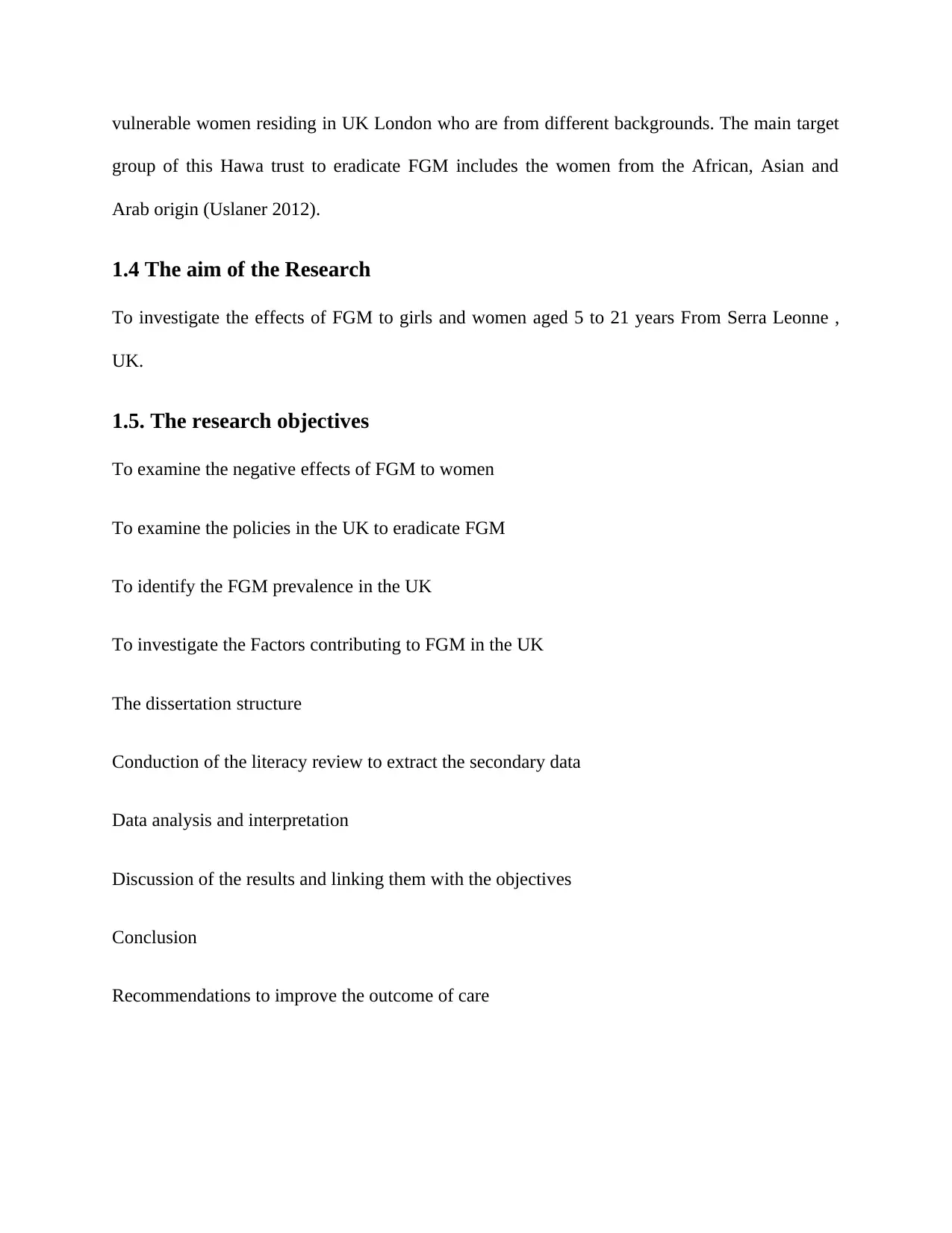
vulnerable women residing in UK London who are from different backgrounds. The main target
group of this Hawa trust to eradicate FGM includes the women from the African, Asian and
Arab origin (Uslaner 2012).
1.4 The aim of the Research
To investigate the effects of FGM to girls and women aged 5 to 21 years From Serra Leonne ,
UK.
1.5. The research objectives
To examine the negative effects of FGM to women
To examine the policies in the UK to eradicate FGM
To identify the FGM prevalence in the UK
To investigate the Factors contributing to FGM in the UK
The dissertation structure
Conduction of the literacy review to extract the secondary data
Data analysis and interpretation
Discussion of the results and linking them with the objectives
Conclusion
Recommendations to improve the outcome of care
group of this Hawa trust to eradicate FGM includes the women from the African, Asian and
Arab origin (Uslaner 2012).
1.4 The aim of the Research
To investigate the effects of FGM to girls and women aged 5 to 21 years From Serra Leonne ,
UK.
1.5. The research objectives
To examine the negative effects of FGM to women
To examine the policies in the UK to eradicate FGM
To identify the FGM prevalence in the UK
To investigate the Factors contributing to FGM in the UK
The dissertation structure
Conduction of the literacy review to extract the secondary data
Data analysis and interpretation
Discussion of the results and linking them with the objectives
Conclusion
Recommendations to improve the outcome of care
⊘ This is a preview!⊘
Do you want full access?
Subscribe today to unlock all pages.

Trusted by 1+ million students worldwide
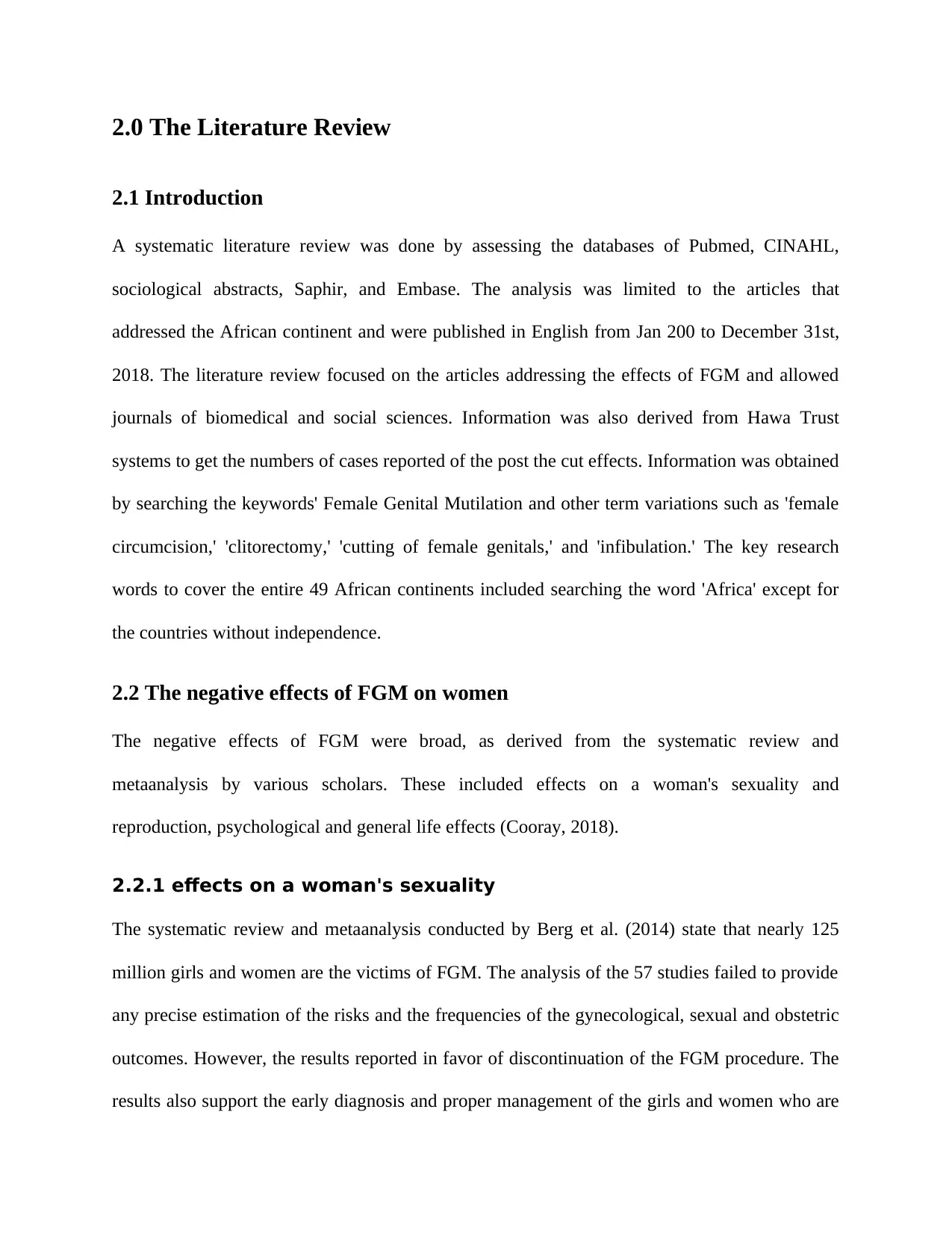
2.0 The Literature Review
2.1 Introduction
A systematic literature review was done by assessing the databases of Pubmed, CINAHL,
sociological abstracts, Saphir, and Embase. The analysis was limited to the articles that
addressed the African continent and were published in English from Jan 200 to December 31st,
2018. The literature review focused on the articles addressing the effects of FGM and allowed
journals of biomedical and social sciences. Information was also derived from Hawa Trust
systems to get the numbers of cases reported of the post the cut effects. Information was obtained
by searching the keywords' Female Genital Mutilation and other term variations such as 'female
circumcision,' 'clitorectomy,' 'cutting of female genitals,' and 'infibulation.' The key research
words to cover the entire 49 African continents included searching the word 'Africa' except for
the countries without independence.
2.2 The negative effects of FGM on women
The negative effects of FGM were broad, as derived from the systematic review and
metaanalysis by various scholars. These included effects on a woman's sexuality and
reproduction, psychological and general life effects (Cooray, 2018).
2.2.1 effects on a woman's sexuality
The systematic review and metaanalysis conducted by Berg et al. (2014) state that nearly 125
million girls and women are the victims of FGM. The analysis of the 57 studies failed to provide
any precise estimation of the risks and the frequencies of the gynecological, sexual and obstetric
outcomes. However, the results reported in favor of discontinuation of the FGM procedure. The
results also support the early diagnosis and proper management of the girls and women who are
2.1 Introduction
A systematic literature review was done by assessing the databases of Pubmed, CINAHL,
sociological abstracts, Saphir, and Embase. The analysis was limited to the articles that
addressed the African continent and were published in English from Jan 200 to December 31st,
2018. The literature review focused on the articles addressing the effects of FGM and allowed
journals of biomedical and social sciences. Information was also derived from Hawa Trust
systems to get the numbers of cases reported of the post the cut effects. Information was obtained
by searching the keywords' Female Genital Mutilation and other term variations such as 'female
circumcision,' 'clitorectomy,' 'cutting of female genitals,' and 'infibulation.' The key research
words to cover the entire 49 African continents included searching the word 'Africa' except for
the countries without independence.
2.2 The negative effects of FGM on women
The negative effects of FGM were broad, as derived from the systematic review and
metaanalysis by various scholars. These included effects on a woman's sexuality and
reproduction, psychological and general life effects (Cooray, 2018).
2.2.1 effects on a woman's sexuality
The systematic review and metaanalysis conducted by Berg et al. (2014) state that nearly 125
million girls and women are the victims of FGM. The analysis of the 57 studies failed to provide
any precise estimation of the risks and the frequencies of the gynecological, sexual and obstetric
outcomes. However, the results reported in favor of discontinuation of the FGM procedure. The
results also support the early diagnosis and proper management of the girls and women who are
Paraphrase This Document
Need a fresh take? Get an instant paraphrase of this document with our AI Paraphraser
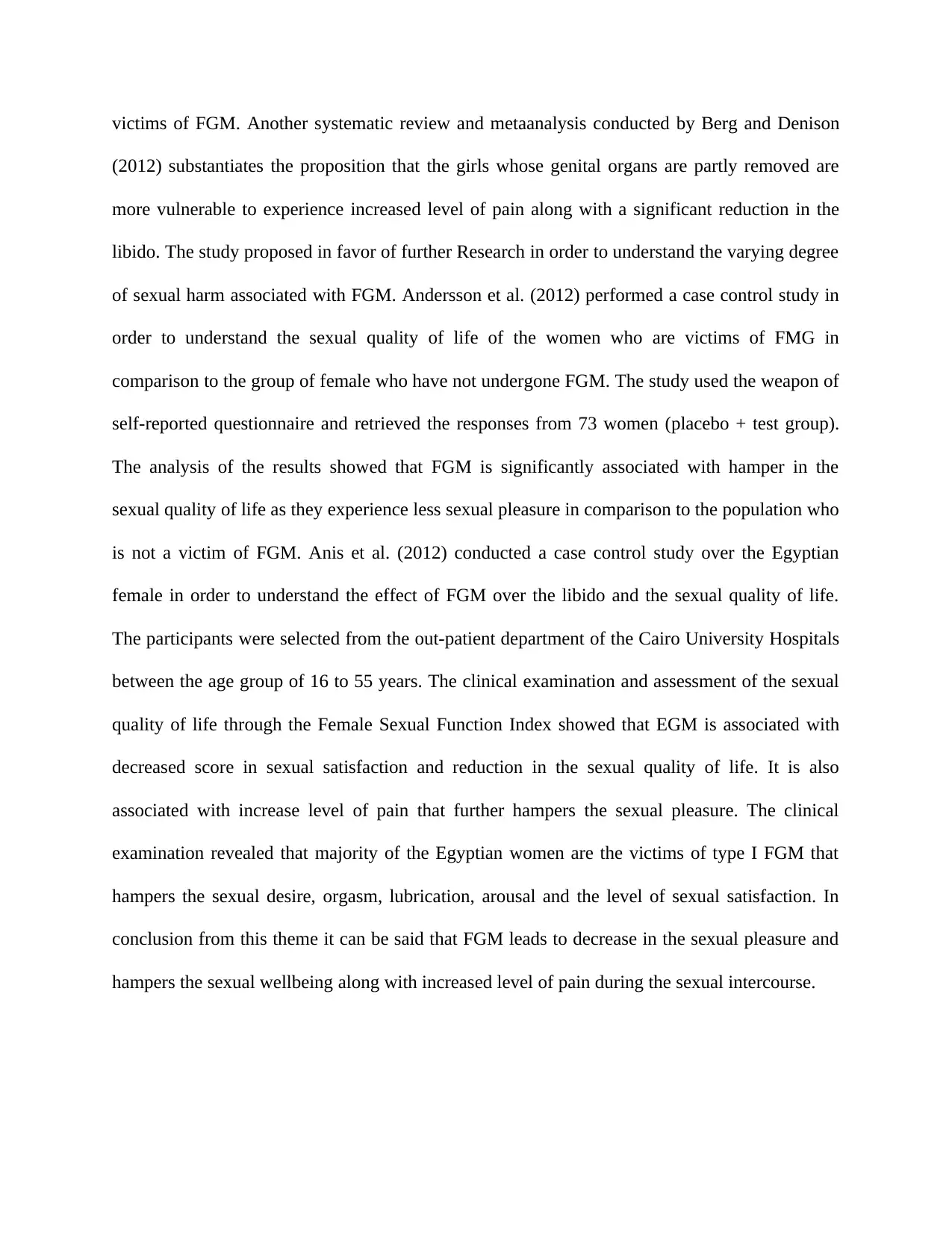
victims of FGM. Another systematic review and metaanalysis conducted by Berg and Denison
(2012) substantiates the proposition that the girls whose genital organs are partly removed are
more vulnerable to experience increased level of pain along with a significant reduction in the
libido. The study proposed in favor of further Research in order to understand the varying degree
of sexual harm associated with FGM. Andersson et al. (2012) performed a case control study in
order to understand the sexual quality of life of the women who are victims of FMG in
comparison to the group of female who have not undergone FGM. The study used the weapon of
self-reported questionnaire and retrieved the responses from 73 women (placebo + test group).
The analysis of the results showed that FGM is significantly associated with hamper in the
sexual quality of life as they experience less sexual pleasure in comparison to the population who
is not a victim of FGM. Anis et al. (2012) conducted a case control study over the Egyptian
female in order to understand the effect of FGM over the libido and the sexual quality of life.
The participants were selected from the out-patient department of the Cairo University Hospitals
between the age group of 16 to 55 years. The clinical examination and assessment of the sexual
quality of life through the Female Sexual Function Index showed that EGM is associated with
decreased score in sexual satisfaction and reduction in the sexual quality of life. It is also
associated with increase level of pain that further hampers the sexual pleasure. The clinical
examination revealed that majority of the Egyptian women are the victims of type I FGM that
hampers the sexual desire, orgasm, lubrication, arousal and the level of sexual satisfaction. In
conclusion from this theme it can be said that FGM leads to decrease in the sexual pleasure and
hampers the sexual wellbeing along with increased level of pain during the sexual intercourse.
(2012) substantiates the proposition that the girls whose genital organs are partly removed are
more vulnerable to experience increased level of pain along with a significant reduction in the
libido. The study proposed in favor of further Research in order to understand the varying degree
of sexual harm associated with FGM. Andersson et al. (2012) performed a case control study in
order to understand the sexual quality of life of the women who are victims of FMG in
comparison to the group of female who have not undergone FGM. The study used the weapon of
self-reported questionnaire and retrieved the responses from 73 women (placebo + test group).
The analysis of the results showed that FGM is significantly associated with hamper in the
sexual quality of life as they experience less sexual pleasure in comparison to the population who
is not a victim of FGM. Anis et al. (2012) conducted a case control study over the Egyptian
female in order to understand the effect of FGM over the libido and the sexual quality of life.
The participants were selected from the out-patient department of the Cairo University Hospitals
between the age group of 16 to 55 years. The clinical examination and assessment of the sexual
quality of life through the Female Sexual Function Index showed that EGM is associated with
decreased score in sexual satisfaction and reduction in the sexual quality of life. It is also
associated with increase level of pain that further hampers the sexual pleasure. The clinical
examination revealed that majority of the Egyptian women are the victims of type I FGM that
hampers the sexual desire, orgasm, lubrication, arousal and the level of sexual satisfaction. In
conclusion from this theme it can be said that FGM leads to decrease in the sexual pleasure and
hampers the sexual wellbeing along with increased level of pain during the sexual intercourse.
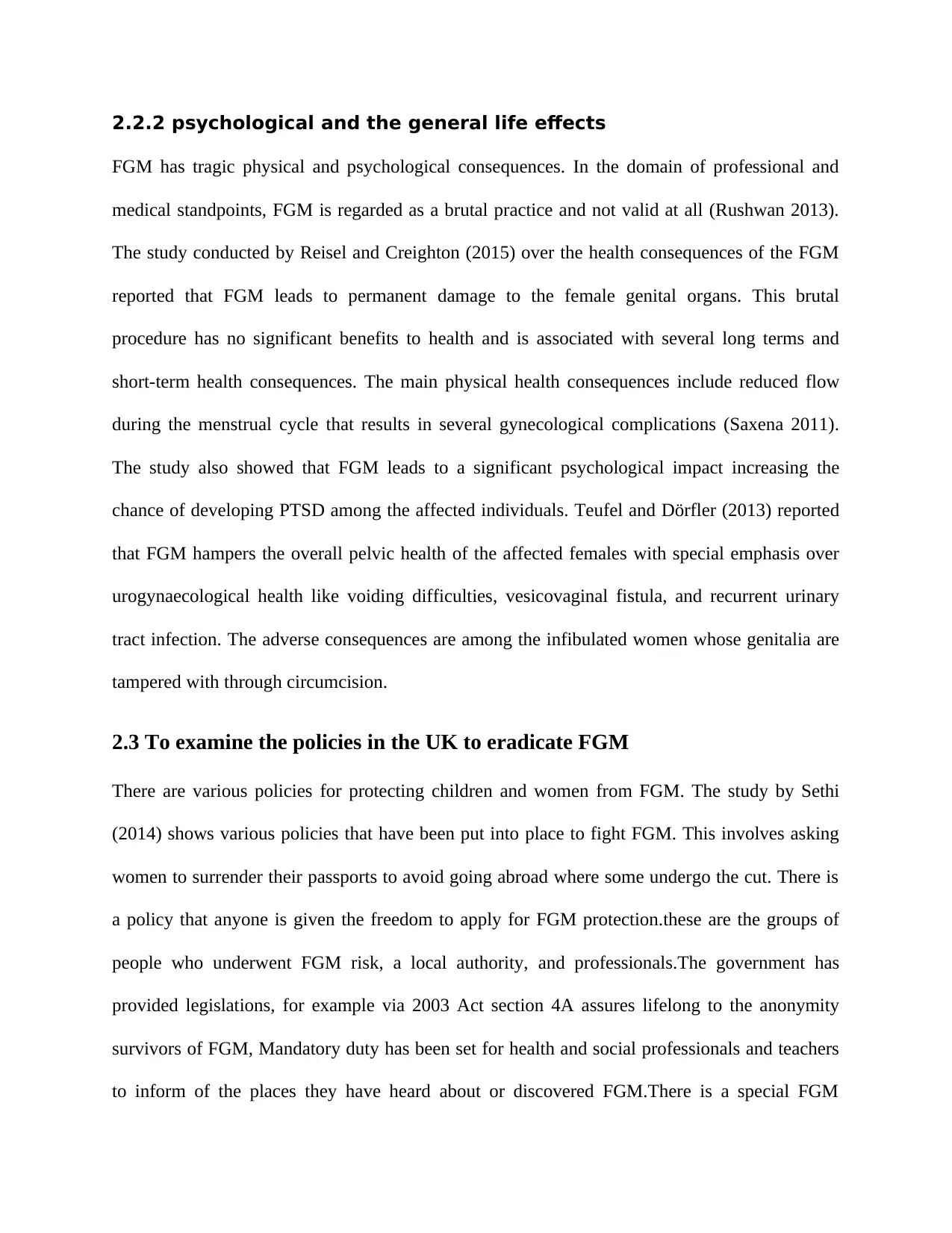
2.2.2 psychological and the general life effects
FGM has tragic physical and psychological consequences. In the domain of professional and
medical standpoints, FGM is regarded as a brutal practice and not valid at all (Rushwan 2013).
The study conducted by Reisel and Creighton (2015) over the health consequences of the FGM
reported that FGM leads to permanent damage to the female genital organs. This brutal
procedure has no significant benefits to health and is associated with several long terms and
short-term health consequences. The main physical health consequences include reduced flow
during the menstrual cycle that results in several gynecological complications (Saxena 2011).
The study also showed that FGM leads to a significant psychological impact increasing the
chance of developing PTSD among the affected individuals. Teufel and Dörfler (2013) reported
that FGM hampers the overall pelvic health of the affected females with special emphasis over
urogynaecological health like voiding difficulties, vesicovaginal fistula, and recurrent urinary
tract infection. The adverse consequences are among the infibulated women whose genitalia are
tampered with through circumcision.
2.3 To examine the policies in the UK to eradicate FGM
There are various policies for protecting children and women from FGM. The study by Sethi
(2014) shows various policies that have been put into place to fight FGM. This involves asking
women to surrender their passports to avoid going abroad where some undergo the cut. There is
a policy that anyone is given the freedom to apply for FGM protection.these are the groups of
people who underwent FGM risk, a local authority, and professionals.The government has
provided legislations, for example via 2003 Act section 4A assures lifelong to the anonymity
survivors of FGM, Mandatory duty has been set for health and social professionals and teachers
to inform of the places they have heard about or discovered FGM.There is a special FGM
FGM has tragic physical and psychological consequences. In the domain of professional and
medical standpoints, FGM is regarded as a brutal practice and not valid at all (Rushwan 2013).
The study conducted by Reisel and Creighton (2015) over the health consequences of the FGM
reported that FGM leads to permanent damage to the female genital organs. This brutal
procedure has no significant benefits to health and is associated with several long terms and
short-term health consequences. The main physical health consequences include reduced flow
during the menstrual cycle that results in several gynecological complications (Saxena 2011).
The study also showed that FGM leads to a significant psychological impact increasing the
chance of developing PTSD among the affected individuals. Teufel and Dörfler (2013) reported
that FGM hampers the overall pelvic health of the affected females with special emphasis over
urogynaecological health like voiding difficulties, vesicovaginal fistula, and recurrent urinary
tract infection. The adverse consequences are among the infibulated women whose genitalia are
tampered with through circumcision.
2.3 To examine the policies in the UK to eradicate FGM
There are various policies for protecting children and women from FGM. The study by Sethi
(2014) shows various policies that have been put into place to fight FGM. This involves asking
women to surrender their passports to avoid going abroad where some undergo the cut. There is
a policy that anyone is given the freedom to apply for FGM protection.these are the groups of
people who underwent FGM risk, a local authority, and professionals.The government has
provided legislations, for example via 2003 Act section 4A assures lifelong to the anonymity
survivors of FGM, Mandatory duty has been set for health and social professionals and teachers
to inform of the places they have heard about or discovered FGM.There is a special FGM
⊘ This is a preview!⊘
Do you want full access?
Subscribe today to unlock all pages.

Trusted by 1+ million students worldwide
1 out of 35
Related Documents
Your All-in-One AI-Powered Toolkit for Academic Success.
+13062052269
info@desklib.com
Available 24*7 on WhatsApp / Email
![[object Object]](/_next/static/media/star-bottom.7253800d.svg)
Unlock your academic potential
Copyright © 2020–2025 A2Z Services. All Rights Reserved. Developed and managed by ZUCOL.





